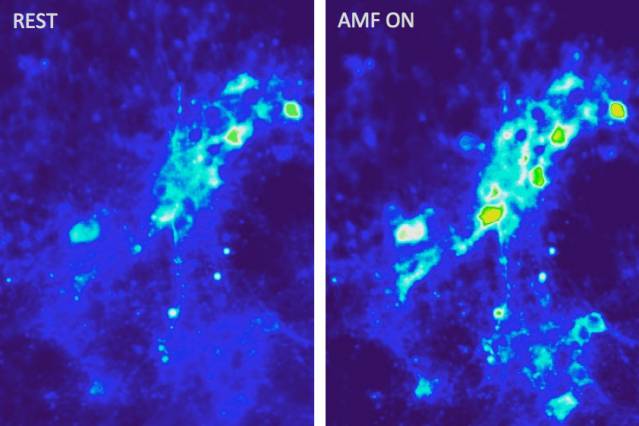 Images show calcium ion influx into neurons as a result of magnetothermal excitation with alternating magnetic fields in the presence of magnetic nanoparticles. Courtesy of the researchers
Images show calcium ion influx into neurons as a result of magnetothermal excitation with alternating magnetic fields in the presence of magnetic nanoparticles. Courtesy of the researchers
MIT researchers have created a technique to stimulate brain tissue using injected magnetic nanoparticles and external magnetic fields.
This new method enables direct neuron stimulation which could be a perfect treatment for a range of neurological diseases without the use of any external connections or implants.
Previous attempts at brain stimulation using electricity pulses have been able to minimise or eliminate tremors related to Parkinson’s disease. However this treatment is very rarely used as there is a need for highly invasive implanted wires, which are connected to an external power source.
In the future, our technique may provide an implant-free means to provide brain stimulation and mapping.
Polina Anikeeva, Assistant Professor of Materials Science and Engineering at Massachusetts Institute of Technology
The research team injected 22 nm diameter magnetic iron oxide particles into the brain. These injected particles tend to quickly heat up when subjected to an alternating magnetic field from outside the brain. The magnetic field is capable of deep penetration into biological tissues.
Wireless brain stimulation
This video shows a calcium ion influx into neurons as a result of magnetothermal excitation with alternating magnetic fields in the presence of magnetic nanoparticles. Neurons on the left have been heat-sensitized with the capsaicin receptor TRPV1; neurons on the left have not. Video Credit: Melanie Gonick/MIT
This increase in the local temperature results in neural activation by triggering capsaicin receptors, which are heat-sensitive. These are the same proteins that play the role of sensing the 'heat' of spicy food and the actual heat in the human body. Viral gene delivery was used by the research team to cause heat sensitivity in specific brain neurons.
The particles, with almost no contact with biological tissues except in the case of being heated, stay at the same place. As a result, long-term treatment is possible without using further invasive techniques.
The nanoparticles integrate into the tissue and remain largely intact. Then, that region can be stimulated at will by externally applying an alternating magnetic field. The goal for us was to figure out whether we could deliver stimuli to the nervous system in a wireless and noninvasive way.
Polina Anikeeva, Assistant Professor of Materials Science and Engineering at Massachusetts Institute of Technology
This new study has established that this is a highly realistic approach. However, considerable amount of work still needs to be done to convert this proof-of-concept into a useful technique for clinical treatment or brain research.
Cancer research has largely concentrated on using injected particles and magnetic fields and it is believed that this approach can destroy cancer cells by subjecting them to heat.
The new technique is derived, in part, from that research. By calibrating the delivered thermal dosage, we can excite neurons without killing them. The magnetic nanoparticles also have been used for decades as contrast agents in MRI scans, so they are considered relatively safe in the human body.
Polina Anikeeva, Assistant Professor of Materials Science and Engineering at Massachusetts Institute of Technology
The team devised methods to create particles in accurately controlled shapes and sizes so that their interaction with the alternating magnetic field applied is increased. Devices were also developed to supply the magnetic field. Current cancer treatment devices, designed to provide powerful heating, were too huge and energy-inefficient to be applied in this research.
The next step in making this technology a reality to be used in humans "is to understand better how our method works through neural recordings and behavioral experiments, and assess whether there are any other side effects to tissues in the affected area," Anikeeva said.
This research has been published in the Science journal.